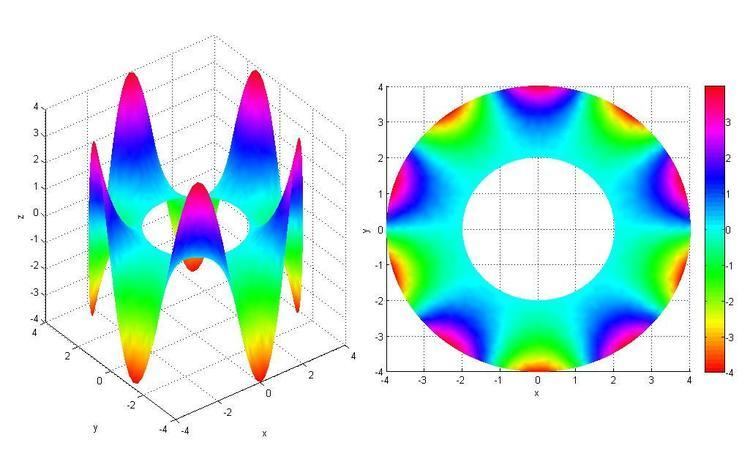 | ||
In the theory of partial differential equations, elliptic operators are differential operators that generalize the Laplace operator. They are defined by the condition that the coefficients of the highest-order derivatives be positive, which implies the key property that the principal symbol is invertible, or equivalently that there are no real characteristic directions.
Contents
Elliptic operators are typical of potential theory, and they appear frequently in electrostatics and continuum mechanics. Elliptic regularity implies that their solutions tend to be smooth functions (if the coefficients in the operator are smooth). Steady-state solutions to hyperbolic and parabolic equations generally solve elliptic equations.
Definitions
A linear differential operator L of order m on a domain
(where
where
In many applications, this condition is not strong enough, and instead a uniform ellipticity condition may be imposed for operators of degree m = 2k:
where C is a positive constant. Note that ellipticity only depends on the highest-order terms.
A nonlinear operator
is elliptic if its first-order Taylor expansion with respect to u and its derivatives about any point is a linear elliptic operator.
Elliptic regularity theorem
Let L be an elliptic operator of order 2k with coefficients having 2k continuous derivatives. The Dirichlet problem for L is to find a function u, given a function f and some appropriate boundary values, such that Lu = f and such that u has the appropriate boundary values and normal derivatives. The existence theory for elliptic operators, using Gårding's inequality and the Lax–Milgram lemma, only guarantees that a weak solution u exists in the Sobolev space Hk.
This situation is ultimately unsatisfactory, as the weak solution u might not have enough derivatives for the expression Lu to even make sense.
The elliptic regularity theorem guarantees that, provided f is square-integrable, u will in fact have 2k square-integrable weak derivatives. In particular, if f is infinitely-often differentiable, then so is u.
Any differential operator exhibiting this property is called a hypoelliptic operator; thus, every elliptic operator is hypoelliptic. The property also means that every fundamental solution of an elliptic operator is infinitely differentiable in any neighborhood not containing 0.
As an application, suppose a function
General definition
Let
We say
We say
for all
The quintessential example of a (strongly) elliptic operator is the Laplacian (or its negative, depending upon convention). It is not hard to see that
Weak ellipticity is nevertheless strong enough for the Fredholm alternative, Schauder estimates, and the Atiyah–Singer index theorem. On the other hand, we need strong ellipticity for the maximum principle, and to guarantee that the eigenvalues are discrete, and their only limit point is infinity.
